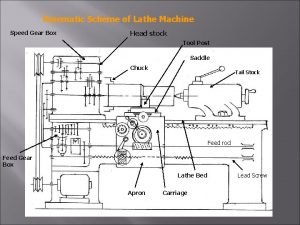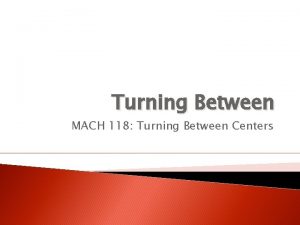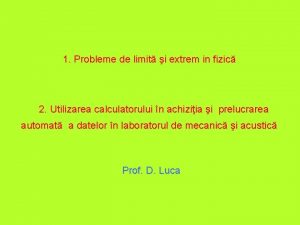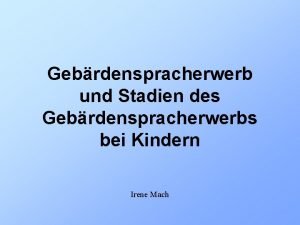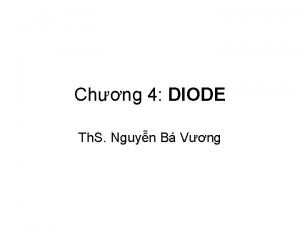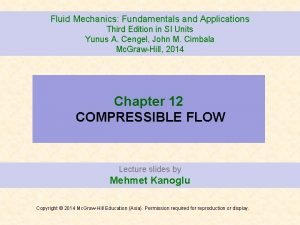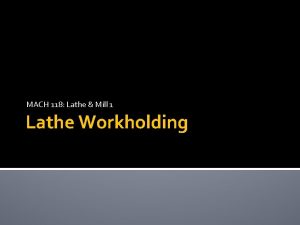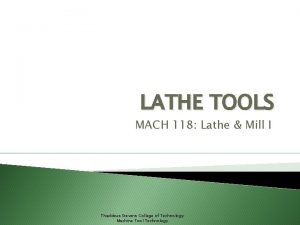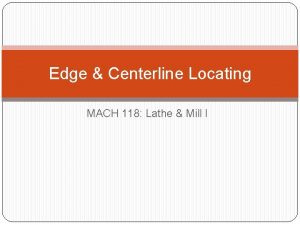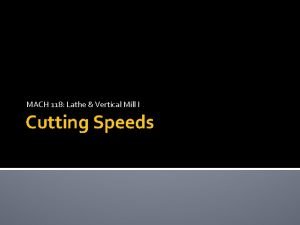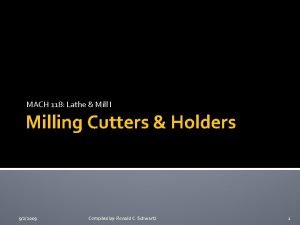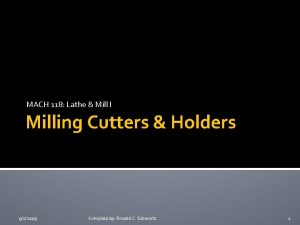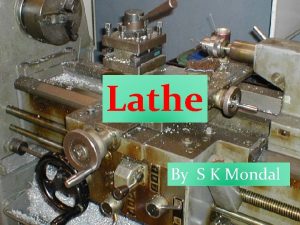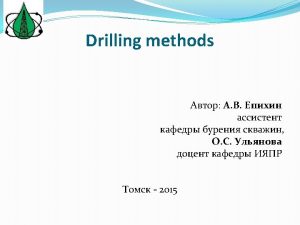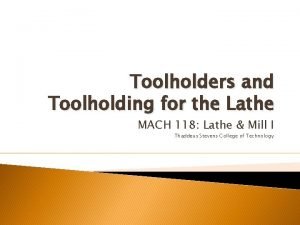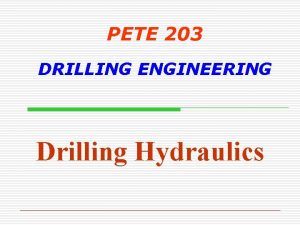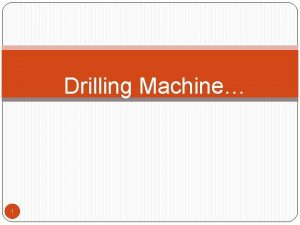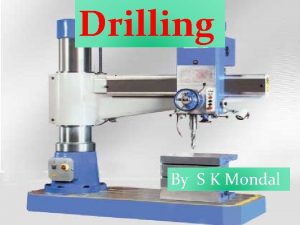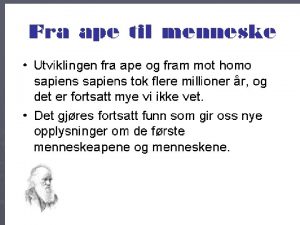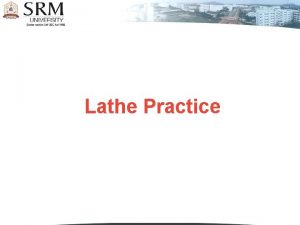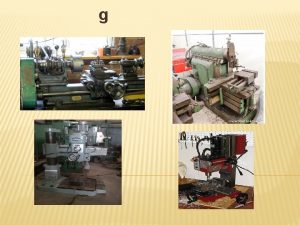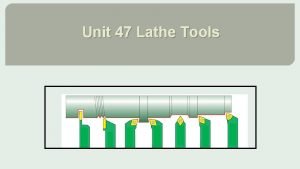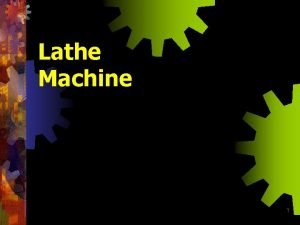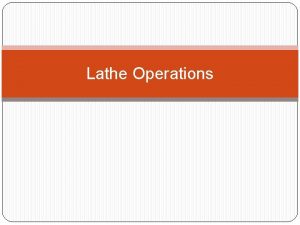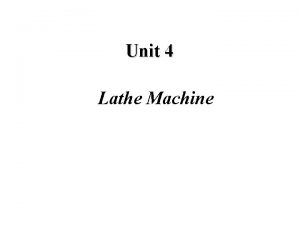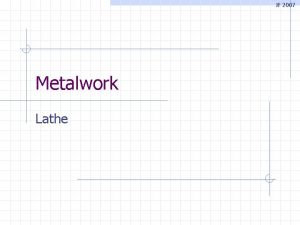Facing Center Drilling MACH 118 Lathe Mill I
























- Slides: 24

Facing & Center Drilling MACH 118: Lathe & Mill I Thaddeus Stevens College of Technology Machine Tool Technology

FACING AND CENTER DRILLING Introduction � Facing and center drilling the workpiece are often the first steps taken in a turning project to produce a stepped shaft or a sleeve from solid material. ◦ Much lathe work is done in a chuck, requiring considerable facing and some center drilling.

OBJECTIVES After completing this unit, you should be able to… � Correctly set up a workpiece and face the ends. � Correctly center drill the ends of a workpiece. � Determine the proper feeds and speeds for a workpiece. � Explain how to set up to make facing cuts to a given depth and how to measure them.

FACING AND CENTER DRILLING Setting Up For Facing � Facing is done to obtain a flat surface on the end of cylindrical workpieces or on the face of parts clamped in a chuck or face plate. ◦ Work is most often held in a three- or four-jaw chuck.

FACING AND CENTER DRILLING Setting Up For Facing � Round stock can be set up using a dial indicator. Fig. I-152 Setting up round stock in an independent chuck with a dial indicator.

FACING AND CENTER DRILLING Setting Up For Facing � Square or rectangular stock can be set up either with a dial indicator or by using a tool-holder turned backward. Fig. I-153 Rectangular stock being set up by using a toolholder turned backward. The micrometer dial is used to center the workpiece.

FACING AND CENTER DRILLING Setting Up For Facing Workpieces can be chucked: Normally. Internally. Externally. Fig. I-156 Internal chucking position. Fig. I-155 Normal chucking position. Fig. I-157 External chucking position.

FACING AND CENTER DRILLING Facing � Facing from the center out produces a better finish, but it is difficult to cut on a solid face in the center. Fig. I-158 Facing from the center to the outside of the workpiece.

FACING AND CENTER DRILLING Facing � Heavier cuts may be taken when facing from the outside, and it is easier to work to the scribed lines on the circumference of the work. Fig. I-159 Facing from the outside toward the center of the workpiece.

FACING AND CENTER DRILLING Facing � Machining should not be done on workpieces extending more than three x dia. from the chuck face.

FACING AND CENTER DRILLING Facing � The tool point should be set to dead center. Fig. I-160 Setting the tool to the center of the workpiece using the tailstock center.

FACING AND CENTER DRILLING Facing � The tool point should be set to dead center.

FACING AND CENTER DRILLING Facing � The carriage may be locked when taking facing cuts. Fig. I-161 Carriage must be locked before taking a facing cut.

FACING AND CENTER DRILLING Facing � Facing to length may be accomplished by trying a cut and measuring with a hook rule or by facing to a previously made layout line. ◦ A more precise method is to use graduations on the micrometer collar of the compound. Fig. I-162 Facing to length using a hook rule for measuring.

FACING AND CENTER DRILLING Facing � The compound slide is set parallel to the ways. ◦ The carriage is locked in place & a trial cut taken with the micrometer collar set on zero index. Fig. I-163 The compound set at 90 degrees for facing operations. Fig. I-164 Close-up of the compound set at 90 degrees.

FACING AND CENTER DRILLING Facing � The workpiece is measured with a micrometer & the desired length is subtracted from the measurement. ◦ The remainder should be removed by facing. �A short trial cut (about 1/8”) should again be taken on the finish cut and adjustment made if necessary. ◦ Cuts can vary considerably, depending on machine size, horsepower, tooling, and setup.

FACING AND CENTER DRILLING Facing � Quite often the compound is kept at 30 degrees for threading purposes. ◦ At this angle the tool feeds into the face of the work. 001 in. for every. 002 in. that the slide is moved. Fig. I-165 The compound set at 30 degrees. Fig. I-166 Close-up of the compound set at 30 degrees.

FACING AND CENTER DRILLING Facing � Both right-hand left-hand facing tools are used for facing work held on mandrels. ◦ Care should be taken when machining pressure is toward the small end of a tapered mandrel. ◦ Excessive pressure may loosen the workpiece on the mandrel. Fig. I-171 Work held between centers on a mandrel can be faced on both sides with right- & left-hand facing tools.

FACING AND CENTER DRILLING Speeds � Speeds (rpm) for lathe turning are determined in essentially the same as speeds for drilling tools. ◦ Work diameter is used instead of drill diameter. � In facing operations, outside diameter of the work-piece has greater surface speed than its center. ◦ The rpm should vary as the tool is moved in or out. ◦ Two or three speed changes may be required to get a uniform surface finish, depending on the size of the work.

FACING AND CENTER DRILLING Center Drills And Drilling � When work is held and turned between centers, a center hole is required on each end of the work. ◦ It must have a 60 -degree angle to conform to the center and have a smaller drilled hole to clear the center’s point. � Facing the workpiece is almost always necessary before center drilling. ◦ An uneven surface can push sideways on the fragile center drill point and break it.

FACING AND CENTER DRILLING Center Drills And Drilling � Center drills are usually held in a drill chuck in the tailstock. ◦ Workpieces are most often supported & turned in a lathe chuck for center drilling. Fig. I-172 Center drilling a workpiece held in a chuck.

FACING AND CENTER DRILLING Center Drills And Drilling � Long workpieces are generally faced by chucking one end and supporting the other in a steady rest. ◦ The greater the work diameter & the heavier the cut, the larger the center hole should be. Fig. I-173 Center drilling long material supported in a steady rest.

FACING AND CENTER DRILLING Center Drills And Drilling � Drilling too deeply causes the center to contact only the sharp outer edge of the hole, a poor bearing surface. ◦ It soon becomes loose & out of round, causing chatter and roughness. ◦ Center drills often are broken from feeding the drill too fast with the lathe speed too slow or with the tailstock off center. Fig. I-174 Correct and incorrect depth for center drilling.

Questions?
 Depericarper meaning
Depericarper meaning In a capstan or turret lathe the tool motion is stoped
In a capstan or turret lathe the tool motion is stoped Between center turning
Between center turning Katy drilling software center
Katy drilling software center Magda mach
Magda mach Papier mach
Papier mach Pendulul mach
Pendulul mach Irene mach
Irene mach Process management in mach
Process management in mach Mach zehnder interferometer leifi
Mach zehnder interferometer leifi Chất bán dẫn
Chất bán dẫn Ic=βib
Ic=βib động mạch bẹn
động mạch bẹn Vẽ mạch logic
Vẽ mạch logic Mach number formula
Mach number formula Mach kernel
Mach kernel Machiavellian personality
Machiavellian personality động mạch đùi
động mạch đùi Mach disk
Mach disk Fanno flow
Fanno flow How to calculate mach number
How to calculate mach number I sut
I sut Algebra terminology worksheet
Algebra terminology worksheet Giải phẫu xương chậu
Giải phẫu xương chậu Magda mach
Magda mach

